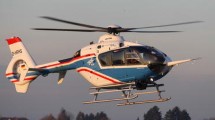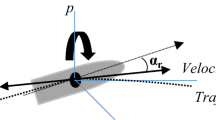Abstract
The Flight Path Reconstruction (FPR) techniques are performed to verify the data compatibility check and post-flight. This is often achieved by calibrating the onboard sensors such as inertial and airdata sensors. In this paper, the limitations of FPR techniques in terms of Maximum Likelihood Estimation (MLE) and Extended Kalman Filter (EKF) and Unscented Kalman Filter (UKF) have been reported. To demonstrate the FPR and sensor calibration, kinematic trajectory simulations with wind box type maneuvers have been performed. It is also shown as how a kinematic simulation is valid for the studies carried out in this work.













Similar content being viewed by others
References
Jategaonkar R V 2006 Data compatibility check. In: Flight Vehicle System Identification A Time Domain Methodology. Chapter 10, Volume 216, Reston, Virginia, AIAA, pp. 335–350
Morelli E A 2002 System Identification Programs for Aircraft (SIDPAC). AIAA, Reston
Morelli E A 2003 Low-order equivalent system identification for the Tu-144LL supersonic transport aircraft. J. Guid. Control Dyn. 26: 354–362
Morelli E A and Klein V 2005 Application of system identification to aircraft at NASA Langley Research Center. J. Aircraft 2: 12–25
Mulder J A, Chu Q P, Sridhar J K, Breeman J H and Laban M 1999 Non-linear aircraft flight path reconstruction review and new advances. Prog. Aerosp. Sci. 35: 673–726
Kamali C, Jain S, Sarf A and Goyal A 2016 Calibration of static pressure sensors using Extended Kalman Filter at high angles of attack and transonic mach numbers. IEEE Xplore. http://doi.org/10.1109/INDIANCC.2016.7441170
Jain S, Kamali C, Yarlagadda Y, Saraf A and Goyal A 2017 Calibration and accuracy determination of airdata system for a modern fighter. AIAA SciTech Forum, (AIAA 2017-1868). https://doi.org/10.2514/6.2017-1868
Kamali C, Jain S and Saraf A 2016 Novel method for static pressure calibration using Unscented Kalman Filter. IFAC-PapersOnLine 49: 646–651. https://doi.org/10.1016/j.ifacol.2016.03.129
Kamali C, Jain S, Yarlagadda Y and Saraf A 2017 Airdata calibration using error state filter. In: AIAA Atmospheric Flight Mechanics Conference, AIAA AVIATION Forum, (AIAA 2017-3895). https://doi.org/10.2514/6.2017-3895
Evans R J, Goodwin G C, Feik R A, Martin C and Lozano-Leal R 1985 Aircraft flight data compatibility checking using maximum likelihood and Extended Kalman Filter estimation. IFAC 18: 487–492
Girija G and Raol J R 1993 PC based flight path reconstruction using UD factorization filtering algorithm. Def. Sci. J. 43: 429–447
Parameswaran V and Jategaonkar R V 2004 Calibration of 5 hole probe for flow angles from advanced technologies testing aircraft system flight data. Def. Sci. J. 54: 111–123
Nusrath K, Sarmah A and Singh J 2014 Flight path reconstruction and wind estimation using flight test data from Crash Data Recorder (CDR). SAE Technical Paper 2014-01-2168, 2014. https://doi.org/10.4271/2014-01-2168
Majeed M and Kar I N 2011 Multi sensor data fusion based approach for the calibration of airdata systems. Aeronaut. J. 115: 113–122
Etkin B 1972 Dynamics of atmospheric flight. Wiley, New York
Author information
Authors and Affiliations
Corresponding author
Appendices
Appendix
The Equations of Motion (EOM) for the simulation is derived from point mass model as follows:
For constant flight path angle and small angles of attack Eq. (26) reduces to
We know
Substitute Eqs. (29) and (32) in Eq. (31)
Hence
Equation (30) can be written as:
Nomenclature
- \( \vec{X}_{Earth} \) :
-
Position in the Earth coordinate
- \( \dot{\overset{\lower0.5em\hbox{$\smash{\scriptscriptstyle\rightharpoonup}$}} {X} }_{Earth} ,V \) :
-
Velocity in the Earth coordinate
- \( \ddot{\overset{\lower0.5em\hbox{$\smash{\scriptscriptstyle\rightharpoonup}$}} {X} }_{Earth} \) :
-
Accelerations in the Earth coordinate
- \( \Phi \) :
-
Euler angles
- \( \phi \) :
-
Bank angle
- \( \theta \) :
-
Pitch angle
- \( \psi \) :
-
Yaw angle
- \( \overset{\lower0.5em\hbox{$\smash{\scriptscriptstyle\rightharpoonup}$}} {g} \) :
-
Gravity vector
- \( \dot{\overset{\lower0.5em\hbox{$\smash{\scriptscriptstyle\rightharpoonup}$}} {X} }_{AC} ,TAS \) :
-
Velocity in the body frame relative to wind
- W :
-
Wind vector in the inertial frame
- \( \alpha \) :
-
Angle of attack
- \( \beta \) :
-
Sideslip angle
- TAS :
-
True Air Speed
- \( V_{Tbias} ,V_{Tscale} \) :
-
TAS bias/offset and scale factor
- \( \alpha_{bias} \,\,\alpha_{scale} \,\,\beta_{bias} \,\,\beta_{scale} \) :
-
AoA bias/offset, AoA scale factor, AoSS bias/offset, AoSS scale factor
- \( u,v,w \) :
-
Velocities in the body frame
- \( u_{wi} ,v_{wi} ,w_{wi} \) :
-
Wind velocities in the inertial frame
- P:
-
Position vector
- \( N_{xb} \) \( N_{yb} \) \( N_{zb} \) :
-
Accelerometer bias
- \( p_{b} \,\,q_{b} \,\,r_{b} \) :
-
Gyro bias
- Suffix ‘m’:
-
Indicates measurement
- ADS:
-
Air Data System
- p q r :
-
Rates
- \( N_{x} \) \( N_{y} \) \( N_{z} \) :
-
Accelerations
Rights and permissions
About this article
Cite this article
Kamali, C., Ozger, E. Limitations of Flight Path Reconstruction techniques. Sādhanā 44, 32 (2019). https://doi.org/10.1007/s12046-018-1019-3
Received:
Revised:
Accepted:
Published:
DOI: https://doi.org/10.1007/s12046-018-1019-3




